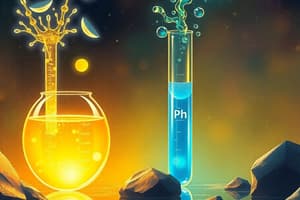Podcast
Questions and Answers
What is the pH value indicating a neutral solution?
What is the pH value indicating a neutral solution?
- 14
- 4
- 7 (correct)
- 0
Which component is necessary for a buffer solution to function effectively?
Which component is necessary for a buffer solution to function effectively?
- Strong acid
- Strong base
- Weak acid and its conjugate base (correct)
- Weak base
What happens if the buffer capacity is exceeded?
What happens if the buffer capacity is exceeded?
- pH will change significantly (correct)
- The solution becomes a strong acid
- Buffer components are destroyed
- pH remains constant
Which equation is used to calculate the pH of buffer solutions?
Which equation is used to calculate the pH of buffer solutions?
What is the typical pH range where most buffers are effective?
What is the typical pH range where most buffers are effective?
Flashcards are hidden until you start studying
Study Notes
pH
- Definition: Measure of the acidity or alkalinity of a solution.
- Scale: Ranges from 0 to 14.
- Acidic: pH < 7
- Neutral: pH = 7
- Basic (Alkaline): pH > 7
- Calculation: pH = -log[H⁺] (concentration of hydrogen ions).
- Importance: Essential for biological processes, enzyme function, and chemical reactions.
Buffers
- Definition: Solutions that resist changes in pH upon the addition of small amounts of acid or base.
- Components: Typically consist of a weak acid and its conjugate base, or a weak base and its conjugate acid.
- Mechanism:
- Weak Acid: Neutralizes added base.
- Conjugate Base: Neutralizes added acid.
- Range: Effective within a specific pH range, usually around the pKa of the weak acid.
Buffer Capacity
- Definition: The ability of a buffer to maintain pH; determined by:
- Concentration of the buffer components.
- Ratio of weak acid to conjugate base.
- Limits: Buffer capacity can be exceeded, leading to significant pH changes.
Applications
- Biological Systems: Blood (carbonic acid-bicarbonate buffer system) maintains pH around 7.4.
- Laboratory: Buffers used in experiments to maintain stable pH environments.
- Industrial: pH control in manufacturing processes like fermentation.
Key Concepts
- pKa: The pH at which a weak acid is half dissociated.
- Henderson-Hasselbalch Equation:
- pH = pKa + log([A⁻]/[HA])
- Used to calculate pH of buffer solutions.
- Common Buffers:
- Phosphate buffer (biological applications).
- Bicarbonate buffer (blood regulation).
- Acetate buffer (biochemical reactions).
pH
- Measures the acidity or alkalinity of a solution on a scale from 0 (most acidic) to 14 (most alkaline).
- Acidic solutions have a pH less than 7, neutral solutions have a pH equal to 7, and basic solutions have a pH greater than 7.
- Calculated using the formula pH = -log[H⁺], where [H⁺] represents the concentration of hydrogen ions in the solution.
- Critical for biological processes, influencing enzyme activity and chemical reactions.
Buffers
- Solutions that stabilize pH levels by resisting changes when small amounts of acid or base are added.
- Typically composed of a weak acid paired with its conjugate base or a weak base with its conjugate acid.
- Function by allowing the weak acid to neutralize excess base and the conjugate base to neutralize excess acid.
- Operate effectively within a specific pH range, typically around the pKa of the weak acid involved.
Buffer Capacity
- Refers to the effectiveness of a buffer in maintaining a stable pH.
- Determined by the concentration of buffer components and the ratio between the weak acid and its conjugate base.
- Buffer capacity has limits; exceeding these can lead to significant fluctuations in pH.
Applications
- Crucial in biological systems; for instance, the carbonic acid-bicarbonate buffer system helps maintain blood pH around 7.4.
- Used in laboratory settings to ensure stable pH for experiments.
- Important in industrial processes, including fermentation, where pH control is essential for product quality.
Key Concepts
- pKa represents the pH at which a weak acid is half dissociated, important for understanding buffer systems.
- The Henderson-Hasselbalch Equation (pH = pKa + log([A⁻]/[HA])) is employed to calculate the pH of buffer solutions.
- Common buffers include:
- Phosphate buffer, utilized in various biological experiments.
- Bicarbonate buffer, vital for maintaining blood pH.
- Acetate buffer, often used in biochemical reactions to maintain consistent pH levels.
Studying That Suits You
Use AI to generate personalized quizzes and flashcards to suit your learning preferences.




